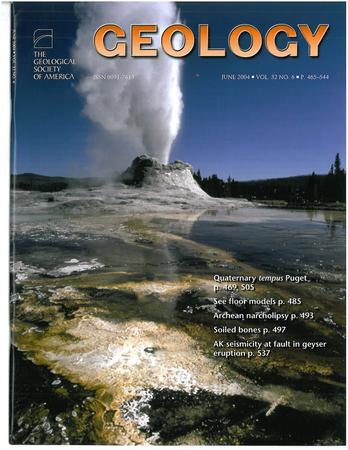Geodynamic controls on slab window volcanism: Insights from the spatiotemporal evolution of the Coast Range Volcanics, California, USA
IF 4.6
1区 地球科学
Q1 GEOLOGY
引用次数: 0
Abstract
Intracontinental volcanism inboard of growing transform boundaries has often been associated with the opening of slab windows following the collision of an oceanic spreading ridge with the continental margin. Yet, the specific drivers of supra-slab-window volcanism remain unresolved, partly due to uncertainties surrounding the spatiotemporal evolution of volcanic activity inboard of the evolving transform boundary. We report the distribution, age, and geochemical evolution of volcanism above a slab window by integrating 33 new zircon U-Pb ages and paired zircon Hf isotope measurements from the Coast Range Volcanics of California (USA) into a paleogeographic reconstruction of western North America from 27 Ma to the present. A cluster of 18−15 Ma volcanic centers in central California are interpreted to have been driven by extension of the Transverse Ranges above a condensed geotherm, while a northwest-younging linear progression of volcanism, spanning ca. 27−3 Ma, is proposed to be associated with the vertical vorticity component of toroidal flow of the shallow mantle around the northwest-migrating trailing edge of the subducting Gorda slab. Furthermore, our model suggests that a 22−12 Ma gap in the northwest-younging volcanic trend was driven by occlusion of the Gorda slab edge by a thick crustal root in the southern Sierra Nevada. This occlusion likely also interrupted or redirected regional eastward shallow-mantle flow beneath the continental margin, putatively reducing asthenospheric traction on the base of the crust below western North America and driving increased rates of extension and volcanism in the Basin and Range province.板块窗火山作用的地球动力学控制:来自加利福尼亚海岸山脉火山岩时空演化的启示
在不断增长的转换边界内的大陆内火山活动通常与在海洋扩张脊与大陆边缘碰撞后的板块窗的打开有关。然而,超板窗火山活动的具体驱动因素仍未得到解决,部分原因是围绕演化转换边界内火山活动时空演化的不确定性。本文通过对美国加利福尼亚海岸山脉火山的33个新锆石U-Pb年龄和配对锆石Hf同位素测量结果进行整合,对北美西部27 Ma至今的古地理重建进行了研究,报告了板窗之上火山活动的分布、年龄和地球化学演化。加利福尼亚中部的一群18 - 15 Ma的火山中心被解释为是由一个浓缩地热之上的横向山脉的延伸所驱动的,而一个向西北年轻的火山活动的线性进展,跨越约27 - 3 Ma,被认为与围绕俯冲戈达板块的西北迁移后缘的浅地幔环向流的垂直涡度分量有关。此外,我们的模型表明,内华达山脉南部的厚地壳根部遮挡了戈尔达板块边缘,导致了西北-年轻火山走向的22 - 12 Ma缺口。这种闭塞很可能也中断或改变了大陆边缘下的区域性东向浅地幔流动,推测减少了北美西部地壳底部的软流圈牵引力,并增加了盆地和山脉省的伸展和火山活动的速度。
本文章由计算机程序翻译,如有差异,请以英文原文为准。
求助全文
约1分钟内获得全文
求助全文
来源期刊

Geology
地学-地质学
CiteScore
10.00
自引率
3.40%
发文量
228
审稿时长
6.2 months
期刊介绍:
Published since 1973, Geology features rapid publication of about 23 refereed short (four-page) papers each month. Articles cover all earth-science disciplines and include new investigations and provocative topics. Professional geologists and university-level students in the earth sciences use this widely read journal to keep up with scientific research trends. The online forum section facilitates author-reader dialog. Includes color and occasional large-format illustrations on oversized loose inserts.
 求助内容:
求助内容: 应助结果提醒方式:
应助结果提醒方式:


